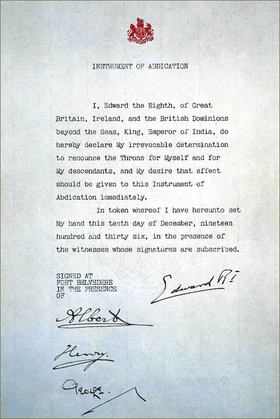His Majesty's Declaration of Abdication Act 1936
His Majesty's Declaration of Abdication Act 1936 (1 Edw. 8 & 1 Geo. 6 c. 3) was the Act of the Parliament of the United Kingdom that recognised and ratified the abdication of King Edward VIII and passed succession to his brother King George VI. The act also excluded any possible future descendants of Edward from the line of succession. Edward VIII abdicated in order to marry his lover, Wallis Simpson, after facing opposition from the governments of the United Kingdom and the Dominions.
| Act of Parliament | |
.svg.png) | |
| Long title | An Act to give effect to His Majesty's declaration of abdication; and for purposes connected therewith. |
|---|---|
| Citation | 1 Edw. 8 & 1 Geo. 6 c. 3 |
| Introduced by | Stanley Baldwin, Prime Minister of the United Kingdom |
| Territorial extent | United Kingdom; British Empire |
| Dates | |
| Royal assent | 11 December 1936 |
| Commencement | 11 December 1936 |
| Other legislation | |
| Relates to | Statute of Westminster 1931 |
Status: Current legislation | |
| Text of statute as originally enacted | |

Procedure and timing
Although Edward VIII had signed a declaration of abdication the previous day—10 December 1936—he remained king until giving Royal Assent to His Majesty's Declaration of Abdication Act, which he did on 11 December,[1] at 1.52 p.m., and the Act became immediately effective from that time.[2]
The act was passed through the British Houses of Parliament in one day, with no amendments. As the Statute of Westminster 1931 stipulated that the line of succession must remain the same throughout the Crown's realms, the governments of some of the British Dominions—Canada, Australia, the Union of South Africa, and New Zealand—requested and gave their permission for the act to become part of the law of their respective realms.
The Canadian parliament later passed the Succession to the Throne Act, 1937 to ratify changes to the rules of succession in Canada and ensure consistency with the changes in the rules then in place in the United Kingdom. South Africa passed His Majesty King Edward the Eighth's Abdication Act, 1937, which declared the abdication to have taken effect on 10 December 1936. Australia and New Zealand did not adopt the Statute of Westminster 1931 until the 1940s and did not pass their own legislation. In the Irish Free State, which had been independent from the United Kingdom as a dominion since December 1922, and in which the monarch still had some diplomatic functions, the Oireachtas (parliament) passed the Executive Authority (External Relations) Act 1936, recognising George VI as king from 12 December 1936.
Legal background
The act was necessary for two main reasons.
First, there was no provision in British law for a sovereign to abdicate. Parliament had to pass a bill to remove the king from the throne. Finally the king had to give royal assent to the legislation, which only then became a law. (This process had to be repeated in the parliaments of the Dominions which had enacted the Statute of Westminster 1931: Canada and South Africa.)
Second, the act ensured that any descendants of Edward VIII would have no claim to the throne, and that the Royal Marriages Act 1772 would not apply to them.
Upon the royal assent being communicated to Parliament on the king's behalf, the act came into effect and Edward VIII ceased to be king. The throne immediately passed to his brother, who was proclaimed King George VI the next day at St. James's Palace, London.
References
- Text of the His Majesty's Declaration of Abdication Act 1936 as in force today (including any amendments) within the United Kingdom, from legislation.gov.uk.
- The Times, No. 47,556, Royal Edition, London Saturday December 12, 1936, p. 17: "Court Circular - BUCKINGHAM PALACE, Dec. 11.
External links
- Text of the His Majesty's Declaration of Abdication Act 1936 as originally enacted or made within the United Kingdom, from legislation.gov.uk.
- "HIS MAJESTY'S DECLARATION OF ABDICATION BILL". Parliamentary Debates (Hansard). House of Commons of the United Kingdom. 12 December 1936. col. 2199–2221.
- Digital Reproduction of the Original Act on the Parliamentary Archives catalogue